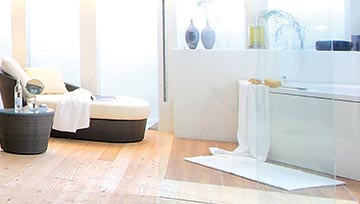Skaben Parquet
Skaben offers you a wide range of parquet floors, both as solid wood planks and as three-layer parquet. Skaben parquet is available in beech, oak, larch and pine in a variety of colours and with various surface finishes. Most of these parquet floors can be laid either floating (glue-free) or fully glued. In terms of design, you can choose between 1-strip plank, 3-strip ship's floor or herringbone.
The properties of Skaben parquet at a glance
- The parquet is a pure natural product.
- It is durable - therefore there is up to 20 years guarantee.
- This parquet is robust and easy to maintain.
- It can be laid over underfloor heating systems that carry water.
- Parquet is always pleasantly warm to the feet.
- The wood of the parquet floor has a balancing effect on the room climate. At high humidity it absorbs moisture, at low humidity it releases moisture.
- Parquet gives the room a cosy, natural atmosphere.
- This type of parquet is not suitable for installation in damp rooms, such as the bathroom.
The advantages of solid wood planks
- Due to the thick wear layer they can be sanded down several times. Therefore they have a longer life span.
- They are made of 100% wood from sustainable forestry.
- Since they are glued, the parquet flooring constructed in this way is quieter than a floating installation.
The advantages of multi-layer parquet
- It is cheaper than solid wood planks.
- It can be installed as a floating floor. This is easier and quicker for laymen than full-surface gluing.
- If it is installed as a floating floor, it can be removed again without leaving any residue. This is important, for example, in a rented apartment.
- The floor can be walked on immediately after installation.
- Its structure makes it less sensitive to changes in shape caused by the absorption or release of moisture.
- Less valuable precious wood is needed for its production. It is therefore more environmentally friendly.
The structure of the multi-layer parquet
The multilayer parquet is also called finished parquet. Its core is an HDF board made of wood fibres - (HDF = High Density Fiberboard). On top of this lies the wear layer made of the selected precious wood. It is usually between 2.5 mm and 3.5 mm thick. Under the HDF board there is the backing layer of softwood. This structure can partially compensate for the expansion or shrinkage movements of the wood by absorbing or releasing moisture.
Accessories for laying the parquet
If you want to install the parquet over a water-bearing underfloor heating system or on a mineral subfloor, you need a moisture barrier, also known as a vapour barrier. This is a thin PE film that prevents moisture from penetrating into the parquet from below. If the parquet is laid as a floating installation, you must always install a footfall sound insulation. The unglued, loose laying parquet forms a resonance chamber with the subfloor. This considerably amplifies the room and impact sound. Without impact sound insulation, it becomes uncomfortably loud, especially in the rooms below. You can create a clean transition between parquet flooring and the wall with skirting boards. These are available in various sizes and designs. These skirting boards are screwed, nailed or fixed with clips. The transition from one room to another can be created with transition profiles. They are usually screwed into the floor. They can also be used to compensate different floor heights.
What you must observe before laying the parquet
Wood is a natural material that reacts to environmental conditions. Therefore, the parquet must acclimatise before installation. To do this, lay the parquet packages with the parquet unopened flat on the floor of the room in which it is to be laid. It must now have at least 48 hours to adapt. Before laying, you must ensure that the subfloor is firm, crack-free, level, dry and clean. Minor unevenness of less than 3 mm can be levelled out by the parquet. Larger unevenness must be removed. In the case of a mineral subfloor (screed), you must ensure that the floor is ready for laying, i.e. it must be sufficiently dry.







